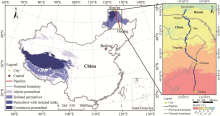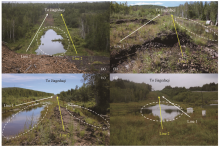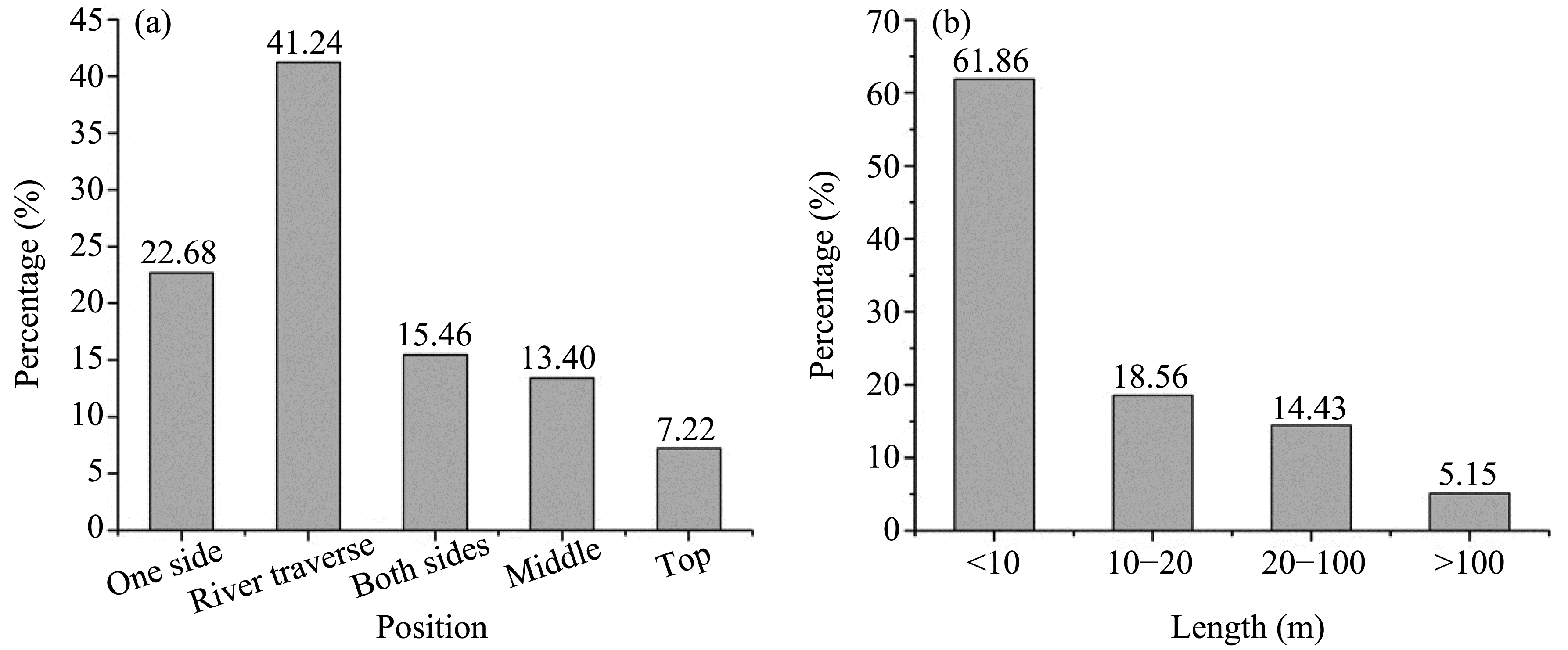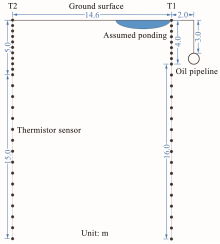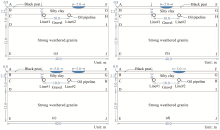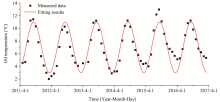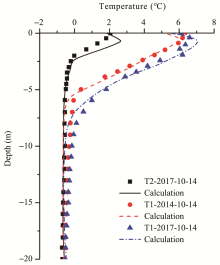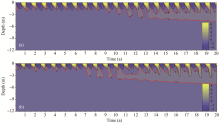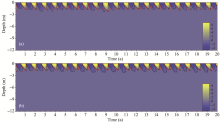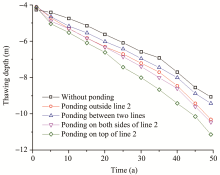Sciences in Cold and Arid Regions ›› 2020, Vol. 12 ›› Issue (2): 59–70.doi: 10.3724/SP.J.1226.2020.00059.
• • 下一篇
Thermal influence of ponding and buried warm-oil pipelines on permafrost: a case study of the China-Russia Crude Oil Pipeline
YanHu Mu1,MingTang Chai1( ),GuoYu Li1(
),GuoYu Li1( ),Wei Ma1,Fei Wang1,2,YaPeng Cao1,2
),Wei Ma1,Fei Wang1,2,YaPeng Cao1,2
- 1.State Key Laboratory of Frozen Soil Engineering, Northwest Institute of Eco-Environment and Resources, Chinese Academy of Sciences, Lanzhou, Gansu 730000, China
2.University of Chinese Academy of Sciences, Beijing 100049, China
| Abdalla BA, Mei H, McKinnon C, et al., 2016. Numerical Evaluation of Permafrost Thawing in Arctic Pipelines and Mitigation Strategies. Arctic Technology Conference. Offshore Technology Conference. | |
| An WD, Wu ZW, Ma W, et al., 1990. Interaction among Temperature, Moisture and Stress Fields in Frozen Soil. Lanzhou: Lanzhou University Press. (in Chinese) | |
|
Burgess MM, Harry DG, 1990. Norman wells pipeline permafrost and terrain monitoring: Geothermal and geomorphic observations, 1984-1987. Canadian Geotechnical Journal, 27(2): 233-244. DOI: 10.1139/t90-027.
doi: 10.1139/t90-027 |
|
|
Brown J, Hinkel KM, Nelson FE, 2000. The Circumpolar Active Layer Monitoring (CALM) Program: Research design and initial results. Polar Geography, 24(3): 165-253. DOI: 10.1080/10889370009377698.
doi: 10.1080/10889370009377698 |
|
|
De Grandpré I, Fortier D, Stephani E, 2012. Degradation of permafrost beneath a road embankment enhanced by heat advected in groundwater. Canadian Journal of Earth Sciences, 49(8): 953-962. DOI: 10.1139/E2012-018.
doi: 10.1139/E2012-018 |
|
|
Dumais S, Konrad JM, 2019. Large-strain nonlinear thaw consolidation analysis of the Inuvik warm-oil experimental pipeline buried in permafrost. Journal of Cold Regions Engineering, 33(1): 04018014. DOI: 10.1061/(ASCE)CR. 1943-5495.0000179.
doi: 10.1061/ |
|
|
Erickson TR, Stefan HG, 2000. Linear air/water temperature correlations for streams during open water periods. Journal of Hydrologic Engineering, 5(3): 317-321. DOI: 10.1061/(ASCE)1084-0699(2000)5:3(317).
doi: 10.1061/ |
|
| Fan SZ, Li GY, Mu YH, et al., 2017. Study on thermal hazards assessment at a typical site along the Mohe-Daqing section of China-Russia crude oil pipeline. Journal of Disaster Prevention and Mitigation Engineering, 37(3): 456-461. | |
|
He RX, Jin HJ, 2010. Permafrost and cold-region environmental problems of the oil product pipeline from Golmud to Lhasa on the Qinghai-Tibet Plateau and their mitigation. Cold Regions Science and Technology, 64(3): 279-288. DOI: 10.1016/j.coldregions.2010.01.003.
doi: 10.1016/j.coldregions.2010.01.003 |
|
|
Hu XY, Sheng Y, Peng EX, 2018. Effect of Thermokarst Lake on Foundation under Embankment in Permafrost Regions. Proceedings of China-Europe Conference on Geotechnical Engineering. Springer, Cham. 1364-1367. DOI: 10.1007/978-3-319-97115-5_101.
doi: 10.1007/978-3-319-97115-5_101 |
|
|
Jin HJ, Hao JQ, Chang XL, et al., 2010. Zonation and assessment of frozen-ground conditions for engineering geology along the China-Russia crude oil pipeline route from Mo'he to Daqing, Northeastern China. Cold Regions Science and Technology, 64(3): 213-225. DOI: 10.1016/j.coldregions.2009.12.003.
doi: 10.1016/j.coldregions.2009.12.003 |
|
|
Jin HJ, Sun GY, Yu SP, et al., 2008. Symbiosis of marshes and permafrost in Da and Xiao Hinggan Mountains in northeastern China. Chinese Geographical Science, 18(1): 62-69. DOI: 10.1007/s11769-008-0062-0.
doi: 10.1007/s11769-008-0062-0 |
|
|
Lai YM, Wang QS, Niu FJ, et al., 2004. Three-dimensional nonlinear analysis for temperature characteristic of ventilated embankment in permafrost regions. Cold Regions Science and Technology, 38(2): 165-184. DOI: 10.1016/j.coldregions.2003.10.006.
doi: 10.1016/j.coldregions.2003.10.006 |
|
|
Li GY, Sheng Y, Jin HJ, et al., 2010. Forecasting the oil temperatures along the proposed China-Russia Crude Oil Pipeline using quasi 3-D transient heat conduction model. Cold Regions Science and Technology, 64(3): 235-242. DOI: 10. 1016/j.coldregions.2009.08.003.
doi: 10. 1016/j.coldregions.2009.08.003 |
|
|
Li GY, Yu QH, Ma W, et al., 2016. Freeze-thaw properties and long-term thermal stability of the unprotected tower foundation soils in permafrost regions along the Qinghai-Tibet Power Transmission Line. Cold Regions Science and Technology, 121: 258-274. DOI: 10.1016/j.coldregions.2015. 05.004.
doi: 10.1016/j.coldregions.2015. 05.004 |
|
|
Li P, Zhang X, Lu X, 2019. Three-dimensional Eulerian modeling of gas-liquid-solid flow with gas hydrate dissociation in a vertical pipe. Chemical Engineering Science, 196: 145-165. DOI: 10.1016/j.ces.2018.10.053.
doi: 10.1016/j.ces.2018.10.053 |
|
|
Mu YH, Ma W, Li GY, et al., 2018. Impacts of supra-permafrost water ponding and drainage on a railway embankment in continuous permafrost zone, the interior of the Qinghai-Tibet Plateau. Cold Regions Science and Technology, 154: 23-31. DOI: 10.1016/j.coldregions.2018.06.007.
doi: 10.1016/j.coldregions.2018.06.007 |
|
| Nixon JF, Oswell JM, 2010. Analytical solutions for peak and residual uplift resistance of pipelines. Proc., 63rd Canadian Geotechnical Conf. and 6th Canadian Permafrost Conference. 570-578. | |
|
Oswell JM, 2011. Pipelines in permafrost: geotechnical issues and lessons. Canadian Geotechnical Journal, 48(9): 1412-1431. DOI: 10.1139/T11-045.
doi: 10.1139/T11-045 |
|
| Périer L, Doré G, Burn CR, 2015. Influence of water temperature and flow on thermal regime around culverts built on permafrost. In: Proceedings of the 68th Canadian Geotechnical Conference and the 7th Canadian Permafrost Conference, 20-23 September 2015. Canadian Geotechnical Society, Québec City, Québec Canada digital release. . | |
|
Seligman BJ, 2000. Long-term variability of pipeline-permafrost interactions in north-west Siberia. Permafrost and Periglacial Processes, 11: 5-22. DOI: 10.1002/(SICI)1099-1530(200001/03)11.
doi: 10.1002/ |
|
|
Selroos JO, Cheng H, Vidstrand P, et al., 2019. Permafrost thaw with thermokarst wetland-lake and societal-health risks: dependence on local soil conditions under large-scale warming. Water, 11(3): 574. DOI: 10.3390/w11030574.
doi: 10.3390/w11030574 |
|
| Smith SL, Burgess MM, Taylor AE, 2003. High arctic permafrost observatory at Alert, Nunavut-analysis of a 23 year data set. Proceedings of the 8th International Conference on Permafrost, 21-25 July 2003, Zurich, Switzerland. AA Balkema, Lisse, the Netherlands, pp. 1073-1078. | |
|
Wang F, Li GY, Ma W, et al., 2018a. Permafrost thawing along the China-Russia Crude Oil Pipeline and countermeasures: A case study in Jiagedaqi, Northeast China. Cold Regions Science and Technology, 155: 308-313. DOI: 10.1016/j.coldregions.2018.08.018.
doi: 10.1016/j.coldregions.2018.08.018 |
|
| Wang F, Li GY, Ma W, et al., 2018b. Influence of Warm Oil Pipeline on underlying Permafrost and Cooling Effect of Thermosyphon based on Field Observations. Proceedings of China-Europe Conference on Geotechnical Engineering. Springer, Cham, pp. 1424-1428. | |
|
Wang YP, Jin HJ, Li GY, 2016. Investigation of the freeze-thaw states of foundation soils in permafrost areas along the China-Russia Crude Oil Pipeline (CRCOP) route using ground-penetrating radar (GPR). Cold Regions Science and Technology, 126: 10-21. DOI: 10.1016/j.coldregions.2016. 02.013.
doi: 10.1016/j.coldregions.2016. 02.013 |
|
|
Wen Z, Zhelezniak M, Wang DY, et al., 2018. Thermal interaction between a thermokarst lake and a nearby embankment in permafrost regions. Cold Regions Science and Technology, 155: 214-224. DOI: 10.1016/j.coldregions.2018.08.010.
doi: 10.1016/j.coldregions.2018.08.010 |
|
|
Wu QB, Zhang TJ, 2010. Changes in active layer thickness over the Qinghai-Tibetan Plateau from 1995 to 2007. Journal of Geophysical Research: Atmospheres, 115: D09107. DOI: 10.1029/2009JD012974.
doi: 10.1029/2009JD012974 |
|
| Xu XZ, Wang JC, Zhang LX, 2001. Physics of Frozen Soils. Science Press, Beijing, China. (in Chinese) | |
|
Yoshikawa K, Hinzman LD, 2003. Shrinking thermokarst ponds and groundwater dynamics in discontinuous permafrost near Council, Alaska. Permafrost and Periglacial Processes, 14(2): 151-160. DOI: 10.1002/ppp.451.
doi: 10.1002/ppp.451 |
|
|
You YH, Wang JC, Wu QB, et al., 2017. Causes of pile foundation failure in permafrost regions: The case study of a dry bridge of the Qinghai-Tibet Railway. Engineering Geology, 230: 95-103. DOI: 10.1016/j.enggeo.2017.10.004.
doi: 10.1016/j.enggeo.2017.10.004 |
|
|
Zhang JM, Qu GZ, Jin HJ, 2010. Estimates on thermal effects of the China-Russia crude oil pipeline in permafrost regions. Cold Regions Science and Technology, 64(3): 243-247. DOI: 10.1016/j.coldregions.2009.10.001.
doi: 10.1016/j.coldregions.2009.10.001 |
| No related articles found! |
|
||

